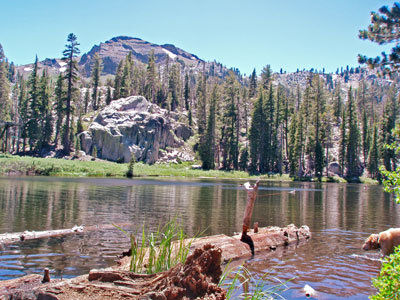
Boy, are we spoiled, living here as we do.
Our climate is just cold enough in the winter to grow delicious fruit that likes a bit of chill, but not so cold that we’re forced inside during those months. Our summers are warm and long, allowing vegetable gardens to thrive, as well as people.
Not so atLake Tahoe, where I recently spent some time. There, cold winters make snow sports reign supreme, and summer brings a short growing season.
Locals told me their lilacs were just now blooming, the peonies were in tight bud and many gardeners don’t bother growing vegetables. Late snow, often into June, and early snow, sometimes in late August, make gardening in the Sierra so much more difficult.
I visited a beautiful nursery, the Tahoe Tree Nursery inTahoeCity, to get a feel for what’s popular in these parts. This destination nursery is landscaped for weddings and also trucks in perennials, trees and shrubs to sell from its growing grounds in Loomis in theCentral Valley.
Quaking aspen grow in lovely stands, providing shade for ferns, hostas and ligularia. A favorite perennial, echinacea or coneflower, was offered in all the hot new colors — Hot Papaya, Raspberry Truffle, Marmalade, Primadonna White — as well as the beautiful magenta standard, Magnus. Many varieties of coreopsis, stachys, lonicera, rudbeckia, kniphofia and hardy geranium are also popular. Rugosa roses do well in this climate, too.
During a hike toShirleyLakein theSquaw Valleyarea, I saw wildflowers in full splendor. Fields of Indian paintbrush, mules ears, penstemon, lupine, phlox and delphinium and Mariposa lily covered the slopes. Early summer kicks off this area’s growing season, and everything was lush with new growth and color when I was there.
Chores at home
In our part of the world, the early wildflower season is almost over, but perennials and flowering shrubs are at their peak and need a bit of attention about now. Here are some tips of what to do in the garden in July.
- Make sure vines have support. Some grow so fast that if you look away for a week, they become a tangled mess. A little maintenance goes a long way in this department.
- Trim back early-flowering perennials to encourage the next flush of blooms.
- Turn the compost pile often, and keep it moist.
- Add additional mulch to planting beds to keeps roots cool and preserve moisture.
- Check ties on trees to make sure they aren’t cutting into the bark.
Propagate a favorite
While you’re out in the garden, take some cuttings from favorite plants, such as roses, hydrangeas, geraniums, trumpet vine, blackberries, lavatera and salvia. Softwood cuttings are taken during the growing season from relatively soft flexible growth.
Gather 8 to 12 inch cuttings early in the day. Discard flowers, buds and side shoots. Then cut the stem into 3 to 4 inch pieces, each with at least two nodes. Keep track of which end is the bottom, and dip in rooting hormone.
Using a pencil, poke holes in a container of rooting medium — try half peat moss or potting soil with half perlite, vermiculite or sand, or use perlite or sand alone — and insert cuttings. Enclose each container in a plastic bag to maintain humidity, opening the bag for a few minutes each day for ventilation. Place the containers in bright shade.
Some cuttings take 4 to 6 weeks to root, while others take longer. Once they have taken root and are sending out new leaves, open the bags. When the new plants are acclimated to open air, transplant each to its own pot of lightweight potting soil.
Enjoy your garden even more this summer by rooting your own plants for yourself or to give away or trade. This is how early settlers filled their gardens, too.
Jan Nelson, a landscape designer and California certified nursery professional, will answer questions about gardening in the Santa Cruz Mountains. Email her at ja******@*ol.com, or visit www.jannelsonlandscapedesign.com to view past columns and pictures.











